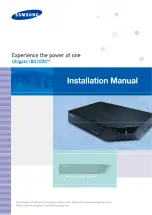
RADWIN
2000+
Series
User
Manual
Release
4.2.40
3
‐
3
Stage
2:
Physical
Survey
3. On
the
urban
map,
check
for
developed
areas
situated
between
the
two
installation
sites.
Pay
attention
to
these
areas
when
performing
the
physical
site
survey;
there
may
be
tall
buildings,
RF
towers,
or
transmitters,
which
could
cause
interference
to
the
link.
4. Check
the
area
between
the
two
sites
for
obstructions
such
as:
•
High
ground
‐
hills
or
mountains
•
Lakes
or
large
bodies
of
water.
Water
has
a
reflection
effect
on
RF
signals
like
a
building.
This
type
of
reflection
causes
the
received
amplitude
to
be
reduced.
As
a
rule
of
thumb,
the
presence
of
a
large
body
of
water
between
the
link
sites
may
double
the
required
antenna
height.
5. Determine
and
record
the
compass
bearings
between
both
radio
units,
relative
to
north.
6. If
there
are
obstructions
between
the
two
sites,
calculate
the
Fresnel
Zone
(see
for
details).
7. If
the
site
chosen
does
not
meet
requirements,
consider
alternative
sites.
8. Use
the
Link
Budget
Calculator
(on
the
CD
supplied
with
the
equipment
or
using
the
RADWIN
Manager)
to
determine
the
expected
performance.
3.5
Stage
2:
Physical
Survey
During
this
stage,
you
review
the
environment
of
the
proposed
installation
location,
to
ensure
that
the
link
sites
are
suitable
for
the
wireless
network.
The
results
of
the
physical
site
survey
should
be
recorded.
To
perform
a
physical
survey:
1.
From
the
compass
readings
taken
in
the
preliminary
survey,
find
the
azimuth
(hori
‐
zontal
position)
that
the
first
ODU
should
face
towards
the
second
ODU.
2. Using
binoculars,
locate
any
obstructions
such
as
tall
trees,
high
buildings,
hills
or
mountains.
Look
for
other
RF
towers
between
the
two
sites.
Mark
the
locations
of
the
obstructions
on
the
map.
3. Determine
the
location
for
the
ODU
(having
regard
for
existing
rooftop
installations
and
tower
space).
It
should
be
above
any
obstructions,
considering
the
Fresnel
zone
(see
).
4. If
you
need
to
install
the
radio’s
antenna
on
a
tower,
make
sure
that
the
tower
is
far
away
from
overhead
electric
power
lines.
When
we
mention
“ODU”,
we
mean
an
outdoor
radio
unit,
or
its
antenna.
If
you
are
working
with
the
RADWIN
2000i,
which
is
an
indoor
unit
and
requires
an
external
antenna,
replace
the
term
“ODU”
with
“the
radio
unit’s
antenna”.
Summary of Contents for 2000+ SERIES
Page 1: ...USER MANUAL RADWIN 2000 SERIES POINT TO POINT BROADBAND WIRELESS Release 4 2 40...
Page 13: ...Part 1 Preliminaries Release 4 2 40...
Page 19: ...Part 2 Basic Installation Release 4 2 40...
Page 83: ...Part 3 Link Management Release 4 2 40...
Page 154: ...Part 4 Site Synchronization Release 4 2 40...
Page 191: ...Part 5 Advanced Installation Topics Release 4 2 40...
Page 221: ...Part 6 Field Installation Topics Release 4 2 40...
Page 251: ...Part 7 Product Reference Release 4 2 40...
Page 267: ...Part 8 Regulatory Notices Release 4 2 40...
Page 275: ...RADWIN 2000 Series User Manual Release 4 2 40 v...
Page 276: ......
















































